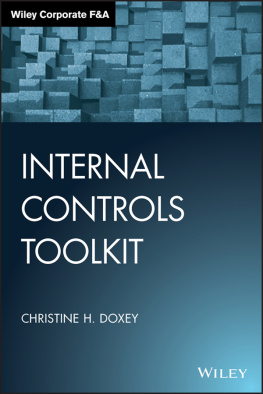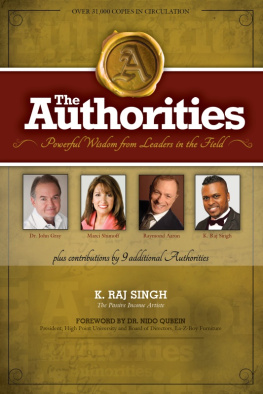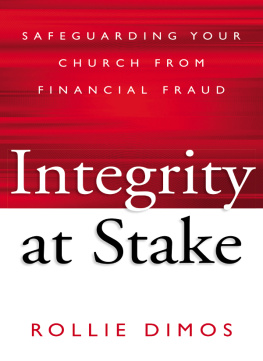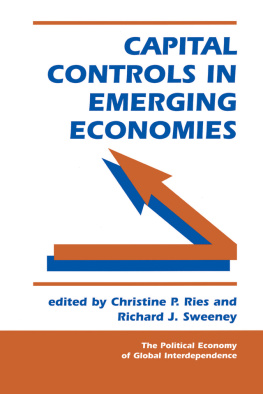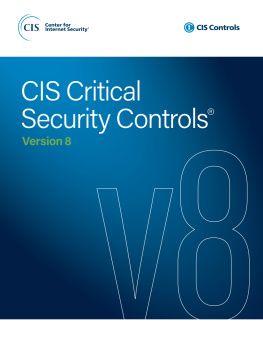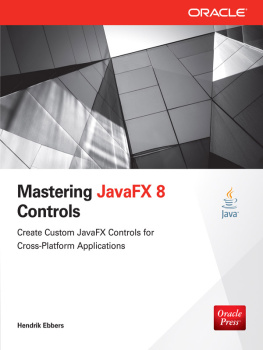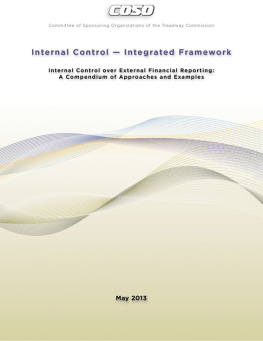
Table of Contents
List of Tables
- Chapter 9
Guide
Pages
Founded in 1807, John Wiley & Sons is the oldest independent publishing company in the United States. With offices in North America, Europe, Asia, and Australia, Wiley is globally committed to developing and marketing print and electronic products and services for our customers' professional and personal knowledge and understanding.
The Wiley Corporate F&A series provides information, tools, and insights to corporate professionals responsible for issues affecting the profitability of their company, from accounting and finance to internal controls and performance management.
Internal Controls Toolkit
Christine H. Doxey

Copyright 2019 by John Wiley & Sons, Inc. All rights reserved.
Published by John Wiley & Sons, Inc., Hoboken, New Jersey.
Published simultaneously in Canada.
No part of this publication may be reproduced, stored in a retrieval system, or transmitted in any form or by any means, electronic, mechanical, photocopying, recording, scanning, or otherwise, except as permitted under Section 107 or 108 of the 1976 United States Copyright Act, without either the prior written permission of the Publisher, or authorization through payment of the appropriate per-copy fee to the Copyright Clearance Center, Inc., 222 Rosewood Drive, Danvers, MA 01923, (978) 7508400, fax (978) 6468600, or on the Web at www.copyright.com. Requests to the Publisher for permission should be addressed to the Permissions Department, John Wiley & Sons, Inc., 111 River Street, Hoboken, NJ 07030, (201) 7486011, fax (201) 7486008, or online at www.wiley.com/go/permissions.
Limit of Liability/Disclaimer of Warranty: While the publisher and author have used their best efforts in preparing this book, they make no representations or warranties with respect to the accuracy or completeness of the contents of this book and specifically disclaim any implied warranties of merchantability or fitness for a particular purpose. No warranty may be created or extended by sales representatives or written sales materials. The advice and strategies contained herein may not be suitable for your situation. You should consult with a professional where appropriate. Neither the publisher nor author shall be liable for any loss of profit or any other commercial damages, including but not limited to special, incidental, consequential, or other damages.
For general information on our other products and services or for technical support, please contact our Customer Care Department within the United States at (800) 7622974, outside the United States at (317) 5723993, or fax (317) 5724002.
Wiley publishes in a variety of print and electronic formats and by print-on-demand. Some material included with standard print versions of this book may not be included in e-books or in print-on-demand. If this book refers to media such as a CD or DVD that is not included in the version you purchased, you may download this material at http://booksupport.wiley.com. For more information about Wiley products, visit www.wiley.com.
Library of Congress Cataloging-in-Publication Data
Names: Doxey, Christine H., 1955- author.
Title: Internal controls toolkit / Christine H. Doxey.
Description: First Edition. | Wiley : Hoboken, New Jersey, [2019] | Series: Wiley corporate F&A series | Includes index. |
Identifiers: LCCN 2019011646 (print) | LCCN 2019021944 (ebook) | ISBN 9781119554400 (Adobe PDF) | ISBN 9781119554417 (ePub) | ISBN 9781119554394 (hardcover)
Subjects: LCSH: Managerial accounting. | Auditing, Internal. | Corporate governance.
Classification: LCC HF5657.4 (ebook) | LCC HF5657.4 .D69 2019 (print) | DDC 658.15/11dc23
LC record available at https://lccn.loc.gov/2019011646
Cover Design: Wiley
Cover Image: Liyao Xie/Getty Images
Introduction to the Internal Controls Toolkit
Introduction
Companies of all sizes are subject to a variety of risks. Among them are legal, regulatory, strategic, operational, financial, and reputational. Each functional organization is subject to one or more of these types of risk, each of which may impact the company's bottom line. Companies use a number of policies and tools, such as insurance, establishment of reserve funds, and investment policies, and standards of control to manage risk.
The concept of internal control is one of the trademarks of effective governance and good business operations. Without a strong system of internal control, organizations cannot ensure that the interests of company stakeholders are being protected. Strong internal controls support organizational goals and objectives, while helping safeguard against the risks of financial loss, operational waste, environmental irresponsibility, corporate fraud, and even reputational damage that can be irreparable. Internal control over financial reporting continues to be a major area of importance in the governance of an organization.
This toolkit provides a series of standards of internal control and the risks they mitigate for all enterprise-wide operations. The fraud risks for today's corporate environment are significant as indicated by the statistics provided in the following sections. The standards will set the foundation for good control and will help to mitigate the risk of fraud. According to the 2018 Report to the Nations prepared by the Association of Certified Fraud Examiners (ACFE), Anti-fraud controls work. The ACFE analyzed 18 anti-fraud controls were analyzed and every one correlated to lower fraud losses and faster fraud detection.
Internal Controls and Fraud Prevention
PwC's 2018 Global Economic Crime and Fraud survey states that:
- 49% of organizations globally said they've been a victim of fraud and economic crimeup from 36%.
- 64% of respondents said losses due directly to their most disruptive fraud could reach US$1 million.
- 52% of all frauds are perpetrated by people inside the organization.
- 31% of respondents who suffered fraud indicated they experienced cybercrime.
Internal Controls and Fraud Prevention: Additional Statistics
| Payment and Business Process Fraud Statistics |
| Organization | Report | Key Findings | Source of Information |
| Association of Certified Fraud Examiners (ACFE) | 2018 Report to the Nations | Occupational fraud is extremely costly. Twenty-two percent of occupational frauds caused at least $1 million in losses. Fraud schemes can be very difficult to detect. The typical occupational fraud lasted 16 months before it was discovered. Tips are the most effective way to detect fraud. Forty percent of cases were detected by a tipfar more than by any other method. Anti-fraud controls work. Eighteen anti-fraud controls were analyzed, and every one correlated to lower fraud losses and faster fraud detection. High-level perpetrators do the most damage. The median loss in frauds committed by owners/executives was $850,000. Among non-owners/executives the median loss was $100,000. Criminal fraud referrals are declining. Over the past 10 years, the percentage of occupational frauds referred to law enforcement has declined by 16 percent. | https://www.acfe.com/article.aspx?id=4295001895 |
| Association of Finance Professionals (AFP) |
Next page
